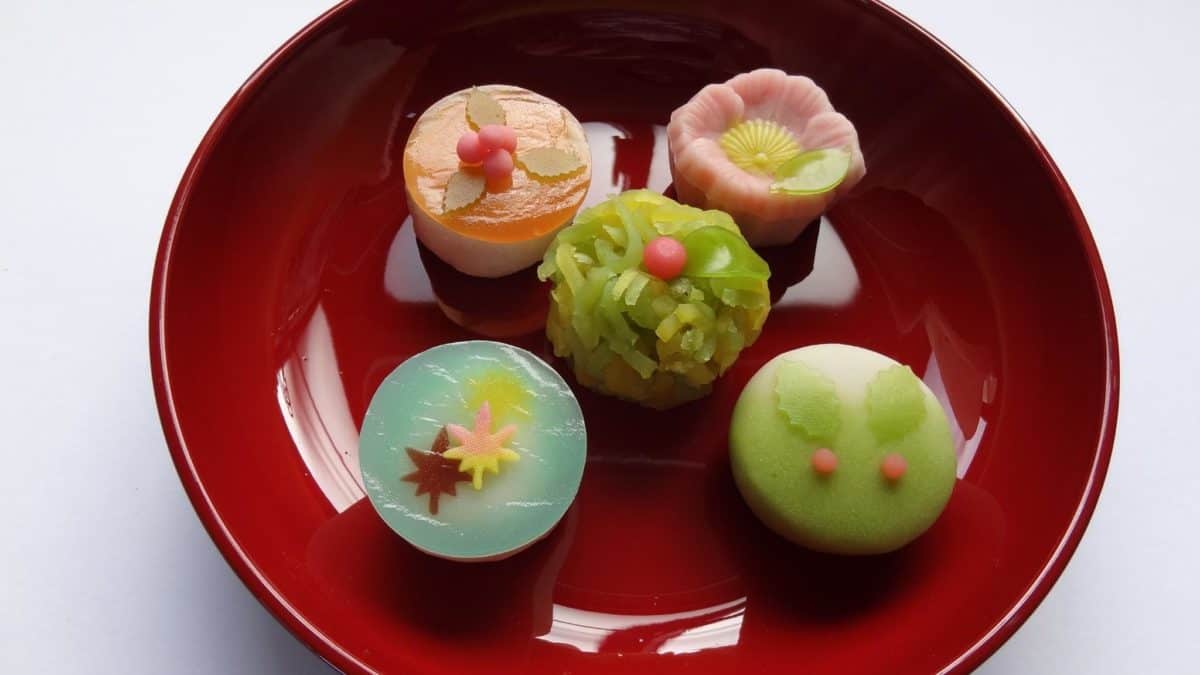Wagashi: The Traditional Japanese Sweets
Wagashi are traditional Japanese sweets often served with tea. It is often made from rice flour or rice dough, sugar, and water, and can be flavored with various fruits or nuts.
Wagashi comes in many different shapes and sizes, and the most popular types are daifuku (a round mochi filled with sweet bean paste).


Check out our new cookbook
Bitemybun's family recipes with complete meal planner and recipe guide.
Try it out for free with Kindle Unlimited:
Read for freeIn this post we'll cover:
What does “wagashi” mean?
Wagashi is made up of two Japanes words, wa meaning Japanese or traditional and gashi meaning sweets. Wagashi therefore translates to traditional Japanese sweets.
It’s a name for all of the sweets that are authentic Japanese, as opposed to yogashi which is sweets that came from the West, or Western influenced. It’s also used to distinguish between handmade sweets and storebought snacks called dogashi.
Wagashi and the tea ceremony
Wagashi are often served with tea, especially during the Japanese tea ceremony. The sweet flavors of the wagashi help to offset the bitterness of the tea, and the different shapes and colors of the sweets can add visual interest to the ceremony.
It’s the essence of Japanese culture and hospitality to be able to offer tea and wagashi to your guests.
Appropriate to the season
Wagashi are also made to be appropriate to the season, using seasonal fruits and flowers as decoration. For example, sakura (cherry blossom) wagashi are popular in the spring, while autumn-themed wagashi might feature leaves or acorns.
There are also specialized wagashi meant to celebrate autumn or spring.
What does wagashi taste like?
Wagashi come in many different flavors, but the most common are sweet bean paste (made from azuki beans) and fruits. The sweetness of the wagashi is usually not as intense as Western sweets, and the textures can vary from soft and chewy to crisp and flaky.
Wagashi making techniques
Wagashi are often made by hand using traditional techniques. The dough is kneaded and shaped into the desired form, and then it is filled with a sweet filling such as bean paste or fruit.
Some wagashi are also made using molds, then the dough is steamed or baked before being filled.
How to eat wagashi
In general, wagashi are meant to be eaten slowly and savored, not gobbled down quickly. They can be enjoyed with tea.
When eating wagashi with tea, it is traditional to take a small bite of the sweet, then take a sip of tea. The bitterness of the tea helps to balance out the sweetness of the wagashi.
If you are eating wagashi on its own, it is best to take small bites and chew slowly to enjoy the different flavors and textures.
What’s the origin of wagashi?
At the end of the Muromachi period, sugar became a staple pantry ingredient because of the increasing trade between Japan and China.
This also introduced tea and dim sum during the Edo period, and so wagashi was born as a little dumpling to be eaten at teatime.
What’s the difference between wagashi and dagashi?
Both are a type of okashi, or sweets, but wagashi are handmade traditional sweets often made for tea ceremonies whereas dagashi are the cheaper storebought sweets like chocolate bars and other pre-packaged candies.
What’s the difference between wagashi and mochi?
Mochi is a type of wagashi made from glutinous rice and water that is pounded into a sticky dough. It can be eaten plain, or filled with sweet bean paste or fruit. So mochi is always wagashi but not all wagashi is mochi.
Types of wagashi
There are many different types of wagashi. Some of the most popular types include:
Daifuku: A round mochi filled with sweet bean paste.
Manjū: A steamed or baked bun filled with sweet bean paste or fruit.
Yokan: A thick, jelly-like dessert made from sweet bean paste, agar agar, and sugar.
Anmitsu: A dessert made from cubes of jelly, sweet bean paste, fruits, and nuts.
Dango: A type of mochi made from rice flour and water, often served on a skewer with a sweet sauce.
Botamochi: A type of mochi filled with sweet bean paste and covered in a sweet soup.
Kuzumochi: A type of mochi made from kuzu (arrowroot) starch, often served with a sweet syrup.
Where to eat wagashi?
If you want to try wagashi, there are many places you can go. Wagashi can be found in Japanese restaurants and cafes, or if you have the pleasure of being invited. tosomeones home for a tea ceremony.
Conclusion
So many wagashi to choose from, and it’s all made in a deliciously traditional and fresh way. Enough not to be able to stay away!
Check out our new cookbook
Bitemybun's family recipes with complete meal planner and recipe guide.
Try it out for free with Kindle Unlimited:
Read for freeJoost Nusselder, the founder of Bite My Bun is a content marketer, dad and loves trying out new food with Japanese food at the heart of his passion, and together with his team he's been creating in-depth blog articles since 2016 to help loyal readers with recipes and cooking tips.
